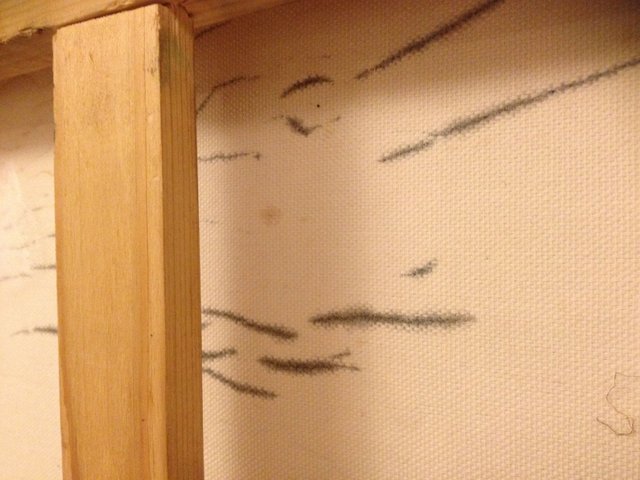Durable materials part 1 : Canvas, Linen, Gesso and Primer
So here I will share some thoughts around ‘archival’ or ‘durable’ techniques and why it is so important to the painter.
Some of the best preserved works are from the Dutch painters and the Germans such as Durer, who apparently offered guarantees (for a pretty penny) that his work would last 500 years or more. There is some display of confidence there, perhaps granted by access to empirical knowledge held within the guild systems of the time about what worked and what didn’t.
When ‘modern science’ came along, we managed to forget a whole lot of these empirically derived forms of knowledge. The painter embraced cotton canvas, embraced chemically bleached and boiled linseed oil (rather than sun oil), embraced acrylic gesso, embraced alkyd resins. All apparently to save some crucial time and convenience.
One of the arguments I hear, is ‘it is SO egotistical to be bothered about whether your work will last past your lifetime, who do you think you are, Michelangelo?’. My argument is contrary : ‘it is SO egotistical to not be bothered about whether your work will last past your lifetime, because people buy your work, invest in you and what you make, and if it disintegrates upon their walls because you couldn’t be bothered to humble yourself to traditional knowledge then you harvest the fruits of modern arrogance’. Ok, I’m putting it a bit strong. But look at what happened to a master painter like Odd Nerdrum and the pickle he got embroiled in due to a passing phase of experimenting with paint medium. His collectors demanded money back, he hid cash in a safe for refunds, got found out by the tax man and went to jail. Its like something from Vasari’s ‘Lives of the Most Eminent Painters Sculptors and Architects’.
It’s worth bearing in mind that painters pour hours of energy, focus and skill into their works, which they render upon some of the most flimsy substances – fabric! I do not argue against painting on fabric, it is a particular joy, but it is obviously not the most enduring or strong substance!
I like linen, it is a tough fabric. I also suspect it is more resistant to the oxidative stress of linseed oil (canvas ‘rot’). But up until a few years ago I painted on pre-stretched cotton from art shops, which came primed in acrylic. This means all my work previous to 2012 is oil on-top of acrylic paint, which I am still not sure is a great idea. Although on the first layer I suspect the oil gets enough ‘mechanical tooth’ into the canvas that it may not cause future problems. Yet, who can say they really know how things will be in 50 years time? This is why I switched to linen and wood and size the surface then and prime my surface with oil. I now only using traditional gesso on wood..
I would say to the painter beware of cheap canvas. It may not even be the canvas which causes the problem, it may be the fragility of weak gesso. Its important to recognise that acrylic gesso is not real traditional gesso – there’s no chalk or rabbit-skin glue in it for starts. But traditional gesso is too fragile for canvas and would be equally vulnerable to cracking.
One of the reasons painters moved from wood to canvas is so they could paint bigger and so they could roll their work for transportation. These are all still important reasons for the modern artist to paint on canvas. But a weak gesso (whether genuine or acrylic based) may crack on rolling. It may even crack when you are painting on it, sometimes pressure is enough to cause a weak gesso to form cracks. When this problem occurs, the paint, the oil will ‘bleed through’ the crack into the back of the canvas, potentially causing canvas rot, and also creating perturbations in the smoothness of the painting via the formation of ridges along the crack-lines.
This only has happened to me once but its obviously big trouble. I bought a canvas in a market from a man stretching and gessoing canvas himself and making a bit of money by doing so. I bought a canvas and worked on it quite lean in the under-painting with primarily just gum turpentine then moving more into oil medium. No problem until 4 or 5 glaze layers later, I started noticing some bleed through the back of the canvas. Other areas started to present – it wasn’t a paint or medium problem, it was a gesso issue. The worst areas were close to the middle vertical stapling at the bottom and top. It looks like, perhaps, he rigorously stretched the canvas after it was gesso’d, and the weak gesso just couldn’t take it. So this is a warning, also, about the possibility of re-stretching causing cracks in acrylic gesso.
So some advice – buy high quality, and if you’re stretching your own roll, check for cracks in the gesso before painting. If you identify gesso cracking, try to sand it down and fill it in with gesso, don’t ignore it at this stage.
Try to avoid traumatising your canvas with too much re-stretching or rolling. When rolling, roll with the painting turned outward. A little counter-intuitive I know, but cracks are perhaps more likely to occur through compression and creasing as through stretching. And don’t roll it too tightly.
Most of the higher quality linen on the market is not reall gesso’d, it is sized with rabbit skin glue and then oil primed. If you are painting with oils or tempera grassa, this seems like a more ‘durable’ approach.
